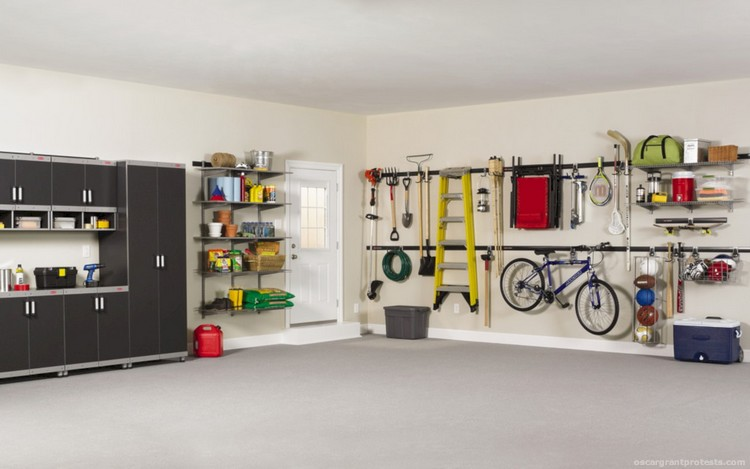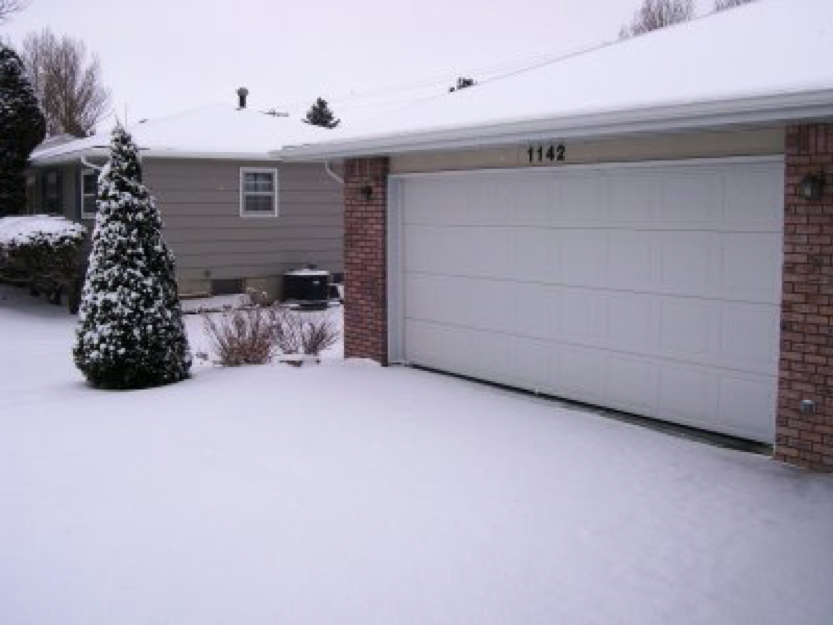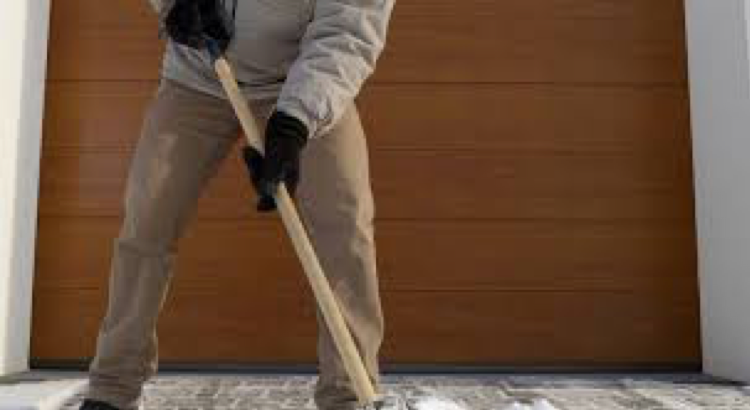Quality vs. Economy: Understanding Roller Garage Doors
Are roller garage doors any good? It’s easy to think that one is as favourable as the next. However, their rising popularity has led to advancements in technologies and design, but also a proliferation of basic, low budget products, where not all will meet the UK standards for quality and safety. With such wide variations, the adage “Basic or Best” has never been more apt especially when applied to the mechanics, materials, quality of the parts, the depth of the side guides, motor quality, construction of the laths, and type of automation and safety system. Therefore, it’s important to ask what you’re not getting for the price. Eastern Garage Doors examines the differences:
How they work
Roller garage doors are usually made from steel or aluminium slats or ‘laths’ that are formed in such a way that they slot into each other and form a pivot. This forms a flexible curtain which can curl around a drum above the opening to form a roll. The best doors are usually coated with a high-quality UV-resistant plastic offering abrasion-resistant surface protection. Guide channels on either side secure the curtain in place to ensure smooth travel. Automation is provided by a tubular operator, control unit and safety system, although manual operation is occasionally asked for.
The Curtain
Roller garage doors open vertically and offer maximum space inside and in front of the garage. Made out of slats (or lathes) in steel or aluminium, there are two choices, single skin, or double skin. When the door is opened, the series of slats coils into a roll above the garage opening without the need for tracks, guided via side channels to ensure smooth travel. Alternatively, if the garage has particularly low headroom (approx. 60 mm) there are also options which allow the curtain to be guided under the ceiling through narrow booms. The slats on high quality options like Hörmann also have curved profiles to make the rolling action much smoother.
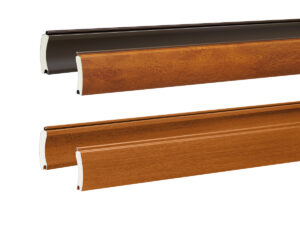
Special abrasion-resistant curved surfaces on Hörmann profiles
General Comparison – Basic vs. Best
Basic: Below £1200 – Single skin curtain constructed of metal, typically steel
Positives:
- Vertical operation saves driveway and internal garage space
Negatives:
- May not be CE marked.
- Curtain is made from thin material which can rattle in adverse weather conditions and are prone to denting and squashing, leading to potential misshaping.
- No insulation.
- May not be wind tested – Produces noise during operation, especially in inclement weather.
- Paint finish scuffs easily.
- Inferior gearing and limits can cause premature failure of motor.
- Non-existent or minimal use of brush strip material can provide a loose-fitting curtain and no sealability.
- Remote security – Poor signal strength can result in system hacking.
Best: £1800–£3200 – Slats consist of two layers of steel or aluminium with insulating material
Positives:
- CE marked.
- Vertical operation saves driveway and internal garage space.
- High-end security systems
- Profile is evenly filled with polyurethane rigid foam for added strength and aiding quiet door travel.
- Insulation can help to regulate temperature inside the garage.
- Resistant to impact – Thicker grade aluminium resists denting and flattening of lathes.
- Thick brush strips reduce noise levels and secure the curtain firmly inside the guide rails for a smooth operation.
- Aluminium door is lighter than steel. With less of a load placed on the door’s opening mechanisms this helps with longevity
- Wind tested & accredited.
- Tension springs support loadings and minimises wear and tear on the motor.
Negatives:
- Whilst there will be some draught exclusion, insulation properties are untested on a fitted door. Because the interlock between the laths/slats are not sealed they are unable to carry a meaningful U value. The gaps simply don’t prevent air and moisture from escaping. (other types of garage door are better, such as sectional garage doors and side hinged garage doors if you want a controlled environment such as a workshop or a home gym).
Wind Rating
A basic curtain, not designed to withstand wind, draws its inspiration from window shutters adapted for garage use. Consequently, it lacks wind shielding capabilities as it originates from a context where wind resistance wasn’t necessary, given the window itself acted as the protective barrier. Doors that are wind rated attach a label showing a particular wind speed classification. This is proof they have been professionally tested and approved for load compliance and will state a designed for wind speed. The minimum wind loading of 2 is for speeds just below 60 mph. A wind class 5 rating would mean it has been tested to withstand winds over 100 mph winds, suited to exposed coastal locations.
The Motor/Controller Component
The motor power required for a single roller door and a double roller door can vary based on the size and weight of the door, the mechanism used, and the frequency of use. It’s essential to consult with a professional installer to determine the exact motor power needed for a specific setup, as they can provide tailored recommendations. Factors such as insulation, wind load, and safety features may also influence the motor power selection.
Performance
A good roller door motor typically offers smoother and quieter operation compared to a cheap one. It may have more robust components that contribute to better performance, such as a higher torque motor or better gearing mechanisms. Good motors often provide consistent and reliable operation, opening and closing the door smoothly without jerky movements or unexpected stops.
Durability
Good roller door motors are designed to withstand frequent use over an extended period. They are often built with higher-quality materials and undergo rigorous testing to ensure durability. Cheap motors may use lower-quality materials and construction methods, leading to a shorter lifespan and potentially more frequent breakdowns, overheating, motor burnout, or electrical failures, leading to downtime and potentially costly repairs.
See the general differences below:
Basic
- 1–5 years motor life
- May not have obstacle detection.
- Fewer additional features
- Produces more noise.
- inferior gears and drives wear out quicker, loose tension or fail causing vibration.
Best
- 25–35 years motor life
- High opening speeds
- Integrated radio control
- Obstacle Detection
- Tamper Resistant
- Manual override
- Can incorporate noise reduction features especially beneficial if the garage is attached to living spaces, and noise minimisation is a priority.
- Soft start and soft stop
- Battery backup systems
- Smartphone integration for remote operation
- Enhanced security measures such as rolling code technology.
- Low power consumption in stand-by mode.
Beware the Bargain
Among the array of garage door types, roller garage doors stand out as the main offenders in misrepresenting the CE mark. Because of the simplicity of manufacturing basic models by sourcing materials from various suppliers, they can be poorly made to meet the bare minimum specification or less. They seldom adhere entirely to the requisite standards for a genuine CE certification and do not have wind testing certification. Always look for bona fide certification.
Safety Features
Most people would expect a new garage door to comply with safety regulations. But that’s not always the case. Built-in safety on the best doors comes in multiple forms including:
Light touch obstacle detection
In the event of the door closing and hitting an obstruction it will reverse back up avoiding people, cars or other objects becoming trapped. This can happen, for example, if the remote button is accidently pressed whilst in your pocket.
Tension springs
The very best roller doors integrate tension springs which allow for smooth operation. These act as a counterbalance to the weight of the roller door curtain. When the door is opened manually or with a motorised system, the tension springs provide the necessary force to lift the door smoothly and evenly. This counterbalancing effect reduces the strain on the motor, making it last three times longer, and ensures that the door can be operated with minimal effort. This protects the operator mechanism and in the case of an emergency the door can be opened by hand without the need of a crank handle. These are sometimes made with multiple spring assemblies coupled with double lifting cables to prevent the door leaf from crashing.
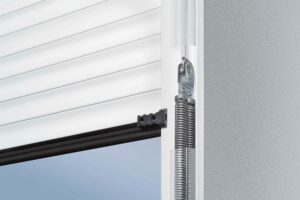
Tension spring technology with spring-in-spring system on Hörmann RollMatic
The Safety Hood
An internal hood/barrel cover prevents people from reaching into the moving mechanism. In addition, it protects the curtain from damage and soiling when the door is open. This is mandatory up to two and half metres in height, and as most domestic installations are below this it is a must have. Not all basic entry level doors have these.
Insulation
The U-value standard, a measure of thermal efficiency, isn’t applied to roller doors due to the inherent design of their lathes and interlocking mechanism, resulting in unavoidable gaps. However, well-constructed roller garage doors typically incorporate double skin lathes filled with dense foam, capable of a degree of heat transfer reduction. Moreover, they include thick brush strips within the guide rails, sealing gaps and minimising noise during operation. In contrast, basic single skin options lack any insulation and utilise minimal seals, leading to heat loss and looser door movement.
Are electric roller doors secure?
Yes, superior quality roller doors are very secure. Reputable manufacturers extensively develop and test door security. The fact that there is no visible lock on an electric roller acts as its own deterrent. The better models use a combination of mechanisms to hold the curtain firmly in place. These can include built in auto locks, spring clamp devices, and anti-lift locking straps, housed within the barrel, which attach to the slats. The quality in these locking devices varies dramatically between manufacturers, so you might need to do a bit more homework to ensure the model you choose is up to the required standard. One certification to look out for is Secured by Design (SBD). This is a certificate awarded to products that have been independently tested and shown to withstand a forced entry attack. Conversely, a lot of cheaper roller garage doors don’t come with suitable locks. Instead of securely locking into place, the roller curtain can just hang in the guides from the barrel above it. Even if it’s held by straps, these can be substandard, and the curtain can be lifted open quite easily. High quality roller garage doors such as the RollMatic can be equipped with remote electronic systems which are exceptionally reliable and secure to 128 bits encryption, similar to online banking security. This level of investment in technology won’t be found in a basic sub £1200 door making it easier for them to be hacked.
The Guide Rails
Guide rails help to keep the door curtain properly aligned as it moves up and down. Generally, the higher the quality of the design and materials the more difficult it becomes to breakthrough a garage door. Special profile arrangements on high-end options have the surety of secure break-in resistant locking making it practically impossible to push the curtain open. Wind locks can also be standard on the best doors securing the curtain profiles in the guide tracks up to high wind loads (class 5). This is a category used in building design and construction to quantify the wind resistance capabilities of structures and building components. Professionally installed guide rails can help reduce noise during operation by ensuring that the curtain moves smoothly without rattling or vibrating against other surfaces. They can also help to secure the door curtain in place, preventing unauthorised access or tampering. Thus, making it more difficult for intruders to force the curtain out of the guide channel and gain entry to the premises. In low budget doors this critical feature can be compromised by substandard materials or manufacturing errors, which affect their strength and integrity, causing curtains to collapse sometimes with the minimum of manual force.
Are warranties all the same?
Basic systems may come with limited warranties reflecting their simpler design and functionality. The best systems have longer warranties, indicating the supplier’s confidence in the durability and performance of the motor, other moving parts, the door, and its finish. Look for 10-year product warranties as a sign of confidence in the product and workmanship guarantees of say five years for the installation. The best manufacturers and installers provide these because they’re assured in the services they offer. You’re also more likely to get a real person on the end of the phone should you need after sales support who are able to deal with the problem, take ownership of it and provide a resolution quickly and efficiently either offering guidance over the phone or by sending an engineer to site.
Designed-In Protection
With the best doors, maintenance features can be purposely designed-in to the fabric of the system. For example, additional surface protection as featured in Hörmann’s Durabelt system, are integral to the upkeep of the door. When rolling up, several belts are placed between the individual layers of the door curtain, significantly reducing scratch marks caused by natural soiling of the door curtain. Additionally, wear-resistant bearing rings also contribute to minimising marks on the inside of the profiles.
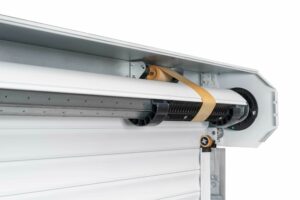
Hörmann DuraBelt system significantly reduces scratches.
Price
Price is a significant factor relative to the level of quality of manufacture on roller garage doors. Yet merely guaranteeing the lowest price holds little value if the product fails to meet expected standards. An eye-catching offer most probably means that many of the benefits are not included. Eastern Garage Doors advises consumers looking for a long-lasting product to be wary of roller doors with an installed price of less than £1200.
For further technical advice contact our experts 0800 048 0741.
Quality vs. Economy: Understanding Roller Garage Doors
In an era defined by technological innovation and an evolving understanding of accessibility, the concept of future-proofing homes is gaining momentum in support of the aging and disabled population. An example of this can be seen in the work being done by the Housing Made for Everyone (HoME) Coalition, a partnership founded by nine organisations calling for the Government to raise building standards so that an ‘accessible and adaptable’ design standard is a mandatory baseline for all new homes. As we strive for inclusivity and convenience when creating living spaces, ‘barrier-free living” can help with mobility inside and outside the home.
The term future proofing encompasses the idea of designing and equipping homes with features that adapt to future needs. When it comes to mobility within the home, doors play a crucial role. Traditional doors, while functional, can present obstacles for individuals with disabilities, especially those using mobility aids such as wheelchairs or walkers. Hence, the evolution of smart doors has become instrumental in ensuring that homes are inclusive spaces.
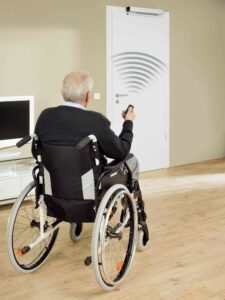
Hand remotes with holder for wheelchair
Smart door technologies encompass a range of features designed to improve convenience, security, and usefulness. Automatic door openers, for instance, enable individuals to enter and exit wide thresholds with ease. These openers can be equipped with motion sensors or controlled remotely via hand transmitters or smartphone apps, offering flexibility and independence to users. Equally so, convenient living can apply regardless of health reasons – handy when carrying full trays or shopping bags!
Moreover, incorporating features like proximity sensors further enhances the user experience, making it effortless to move from one room to the next. By embracing these advancements, house builders and home improvers can ensure that accommodation is functional as needs evolve.
Furthermore, garages often present unique challenges. Accessing a mobility scooter, for example, can be a daunting task. Traditional garage doors operated manually may require physical strength and coordination, posing barriers to entry for some.
However, developments in garage door designs have evolved to offer solutions that cater to diverse needs. There are features that can help. Some insulated sectional garage doors have an epdm bottom seal that closes against the floor creating an efficient seal without a raised threshold. Whilst side hinged options can have a thin strip instead of the small step seen on more established styles.
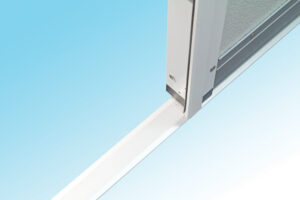
Thin strip threshold
Strong and rigid, they can also be light and easy to open, and the door handle easy to operate (extensions can be added to these to provide more leverage). Doors can be configured with asymmetric leaves – with one a much smaller width than the other and perfect for nipping in and out of the garage in a wheelchair without needing to open both!
Home automation systems also allow users to operate garage doors remotely, through wireless wall buttons or fingerprint recognition. For individuals with disabilities, this means greater independence and convenience.

Home automation systems
Furthermore, features such as obstacle detection enhance safety, providing peace of mind, whilst Police Approved Designs can give homeowners not only improved accessibility but also elevate the overall security of a property.
In the quest for future-proofed homes, inclusivity should remain a central focus. Designing spaces that accommodate individuals of all abilities not only promotes equality but also enriches the lives of occupants. As technology continues to advance, the possibilities within the home are plentiful. By harnessing the power of smart door solutions, homeowners can create spaces that are not only future-proofed but also welcoming and inclusive for all.
Here are some more mobility aids that can be effective:
- Single button easy press remotes
- Motion sensors
- Wider entryways (Wheelchair access)
- Low profile thresholds
- Easy use handles
- Mobility APPs/Smartphone opening
- Wall buttons
- Flashing light for closing sequence
- Soft close feature
- Fingerprint swipe opening
- Remote holders for wheelchairs or scooters
- Key turners
- Electric door release
- Police approved designs
- Insurance approved
- Solar/Battery back up
- Variable height viewers
- Audible warning signals for closing sequence
- Voice command opening from phone
- Front door opening devices
Smart Door Solutions for Enhanced Mobility
Third-party research into garage door trends show “Increasing demand for products that are environmentally sustainable and Eco-friendly.” So, is the traditional up and over garage door, not known for its energy saving qualities, set to become obsolete on building sites? The answer is no, not entirely, but designs are evolving, and other types are making an appearance. Hans Garbutt of Eastern Garage Doors looks at how manufacturers are pressing forward with their green agendas and how it’s impacting on garage door designs.
Individualising Home Styles
Up and overs are commonly installed on sites all over the UK, attributing to their straightforward appearance and low cost. They have been a mainstay for decades, yet of all the designs they are the draughtiest. The trade-off has always been that up-and-over doors are regarded as an inexpensive alternative to other designs. Now, homeowners are looking for a more unique look, and whilst traditionally they remain a popular choice for budget-conscious projects, bespoke products are meeting specific requirements and preferences for higher value architectural house building categories.
The key lies in garage doors, operators, frames, and components delivering long-lasting performance and quality, fortified with modern methods of manufacture that are evolving with improving standards and the industries quest for Eco-friendly house construction.
Here are three examples that House Developers can consider in a similar fashion to other thermally adept ‘building fabric’ elements. They have been designed and developed to specifically help support and build the energy efficient homes of the future:
Being Energy Efficient
Italian manufacturer Silvelox, operating in the UK, provides a self-lifting counterweight design without the need for tracks, enabling greater scope in design flare. It is a complete departure from the familiar tracked ‘torsion spring balance’ system synonymous with the traditional up and over garage door. Within a multi-layer panel is a honeycomb structure that provides thermal and acoustic insulation. These stylish doors are very popular in high end properties.
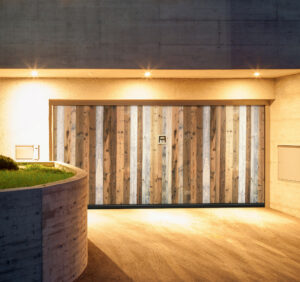
Manufacturer Novoferm also reflects preferences for custom finishes combined with energy efficiencies. The company’s Evolution Premium offering, blends styling akin to a custom wood unit, as well as metallic, luminous, and pearl effects, with a panel design that provides thermal separation between its outer and inner shells. This offers a notable enhancement in heat insulation, with a thermal resistance value of 0.46 W/m2K.
Hörmann UK produce a sectional line that also provides some of the lowest U-values below 1.0 W/m² K, made from a metal-foam-core that integrates a thermal break-system. Their commitment to the green agenda also includes the development of CO2-neutral products as a standard in their garage door designs, manufacturing and supply.
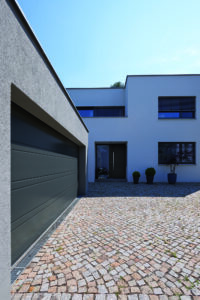
Summary
Homeowners gravitating toward sustainability will drive an uplift in the installation of bespoke, individually styled garage doors, supporting changing habits over design choices on residential building projects. Factors such as kerb appeal, market value, saleability and profitability will increasingly play a significant role in complementing different needs. For home designers, architects, and housing developers the explosion of styles which has proliferated over recent years is continuing to evolve and will require original thinking to match nuanced home buying behaviour.
The Next Wave of Garage Door Designs
One term that often crops up in discussions about garage doors is “galvanisation.” But what does it mean for a garage door to be galvanised? And if so, what benefits does it bring? In this blog, we explain the benefits galvanising provides and uncover the reasons behind its popularity.
Understanding Galvanisation
Before delving into the specifics of steel garage doors, let’s understand what galvanisation is. It is a process that involves coating metal, usually steel, with a layer of zinc to protect it from corrosion. This is done through a chemical process or by dipping the metal into molten zinc, resulting in a protective zinc layer that acts as a barrier against rust, moisture, and other environmental factors that can degrade metal over time.
Are Garage Doors Galvanised?
Yes, garage doors are often galvanised, especially those produced by top manufacturers who utilise high-quality galvanised steel in the construction of up and over garage doors. The base metal is protected by a zinc coating, which serves as a barrier against corrosive elements. Additionally, all surfaces, including up to the cut edges, are covered with a polyester primer coating and a generous layer of powder-coat paint for added protection. Similar production methods are used for other door styles like side-hinged and sectional doors, with steel panels typically encompassing a foam filling for enhanced insulation. Manufacturers such as Garador and Hormann, known for their thick gauge steel, invisible welding, durable powder coat finish, and robust counterbalance lifting gear, offer a 10-year guarantee.
Additional elements
Top-tier models go beyond just the door panel when it comes to galvanisation. Another essential component of a garage door is the torsion spring. The torsion spring stores energy, creating torque that aids in the opening and closing of the door. Additionally, these springs can also have a zinc coating. The quality of the steel used is also crucial in providing the necessary structural strength for a garage door. High-quality up and over options are constructed around a frame, which acts as a boundary structure. This frame is made from high-grade galvanised steel, serving as a sturdy chassis that ensures a robust and stable door construction. Furthermore, galvanised steel braces are used to provide leaf reinforcement, enhancing the door’s stability.
Conclusion
When considering a garage door for your home, the question of whether it’s galvanised is an important one. It offers remarkable benefits, from enhanced corrosion resistance and longevity to reduced maintenance requirements. So, if you’re looking for a durable, low-maintenance garage door that can withstand the test of time, this cost-effective option might just be the perfect choice for you. Other materials are available including grp, timber, or aluminium.
Exploring the Strengths of Galvanised Garage Doors
For car enthusiasts, the garage is more than just a place to park vehicles; it’s a haven to securely park and showcase prized possessions. As your collection grows or you delve into custom projects, space limitations become apparent. One solution to this problem is to broaden your garage door entrance. Eastern Garage Doors explores the benefits of doing this and the crucial role lintels play in this process especially when transforming two single garages into one.
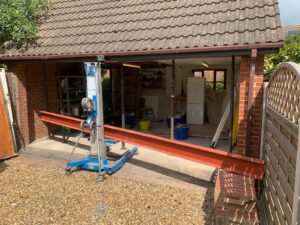
Why consider?
Accommodate Valuable and Larger Vehicles:
Renovating classic cars to their former glory and the emergence of larger SUVs and specialty vehicles, makes maneuverability around tight openings where there is a central pillar in the way very restrictive. Removing this barrier allows you to comfortably park and access your garage space without the risk of accidental damage or scratches. It can give you the confidence to get in and out of the garage without scraping the car or knocking off a wing mirror. With a more accessible entrance you can manoeuvre the car into a better position that’ll suit you.
Facilitate Car Modifications:
Enhancing your vehicle’s performance and appearance is a breeze when you have ample garage space dedicated to this purpose. This allows you to work on your car with ease and create a space tailored to your needs. Furthermore, specialist garage fit out services can help you to efficiently use the extra room by making tooling and the working area much more practical.
Improve Accessibility:
Increasing entrance space can also improve accessibility for individuals with mobility challenges. Garage door specialists can provide special zero-rated VAT garage door adaptions for the disabled subject to status. Adding a double door can in some instances make your garage more wheelchair friendly. No one wants to get soaked in the rain whilst trying to park in a tight space.
Saves on servicing:
Having one door is less expensive than two. You will find yourself having to do less repairs on one single door, and it goes without saying it’ll require less general maintenance than two.
The Role of the Garage Door Lintel
Now that we’ve highlighted the benefits of increased garage access, let’s delve into the significance of lintels in this process:
Structural Support:
One aspect of broadening garage door access is the process of cutting into the current wall or removal of a central pillar to make a bigger opening. This modification can compromise the structural strength of the wall, so it is crucial to add extra support. Lintels are used to span the expanded opening and ensure proper distribution and support of the weight from the wall above.
Load-Bearing Capacity:
Lintels are offered in a range of materials, such as steel, reinforced concrete, and engineered wood, each providing distinct load-bearing capabilities. Expert surveyors meticulously select the suitable lintel according to the dimensions of the garage door and the weight it must bear, thereby avoiding any potential structural problems.
Even Weight Distribution:
A well-installed lintel ensures that the additional load created by the larger garage door is evenly distributed along the lintel’s length. This ensures that any new installation functions smoothly and safely.
Professional Installation and Lintel Selection:
Lintel installation is a complex process that require the expertise of experienced professionals. Therefore it is vital to seek an expert. Consult with a reputable garage door specialist who can assess your garage’s current structure and advise on the appropriate lintel type and size for your project. They will also ensure high-quality materials are used and have the skills and tools to cut the brickwork accurately and install the lintel for optimal performance and safety.
Conclusion
Creating more entry/exit space is a fantastic option, making the garage more versatile and accommodating. Remember that such modifications require meticulous planning and professional execution.
The role of lintels cannot be overstated. They not only distribute the weight of the wall above the opening but also prevent potential wall damage and ensure smooth operation of the garage door.
So, whether you dream of parking a larger SUV or a custom-built automotive masterpiece, or have restrictive mobility, consider the possibilities that creating more capacity to get and work around your garage offers. Invest in professional guidance and materials to create a secure and usable space where you can continue to nurture your passion for cars or simply address a long-standing problem of difficult access.
Revamp Your Car Haven
Garage Doors aren’t always an obvious weak point in your home when looking to save energy. Some of the leading culprits are typically windows, front doors, or poor insulation in the attic. Although this isn’t a particular issue with detached garages, heat loss in a home which has an integral garage perhaps under a bedroom, or used as a home office or gym, can be a problem. The amount of loss can vary depending on the size of the garage door, the type of insulation, and the weather. In this article we look at some of the best performing pre-insulated garage doors and contributing factors – What materials are the best? How can good design influence the outcome? Why does quality manufacture count?
What is the measure for heat loss?
Guidance amongst manufacturers is provided through U-values. The U value of a garage door is a measure of the amount of heat that passes through a surface area of 1m2 for each degree of temperature difference between the inside and outside. Therefore, the lower the U value, the more energy-efficient the material is.
Are there any building regulations?
Although there is no specific legislation directly applying U-values to insulated garage doors, Part L of the Building Regulations, concerning the conservation of fuel and power, does deal with garage conversions, for example when a previously exempt unheated space becomes part of a heated dwelling. A garage door used to access the space, if being retained or upgraded, may have to adhere to ‘change to energy’ status, in which case the energy efficiency requirements outlined in the regulations may apply.
Multi-layered protection.
In a similar fashion to people wearing lots of clothing layers in winter, garage door manufacturers use multi-layered construction techniques to save energy. This involves different materials to create a sandwich-like double skin in steel, aluminium, or vinyl, around rigid foam. This provides excellent insulation properties while maintaining the strength and durability of the door.
Examples of these include:
- Novoferm’s Evolution Premium, constructed as a broken sandwich panel design to create thermal separation of the outer and inner shells. The benefit is a significantly improved heat insulation value equal to 0.46 W/m2K when compared to other door solutions with 45 mm section thicknesses. (See highlights below)
- The Novoferm ISO70, a sub 1.0 W/m² K insulator which similarly comprises built-in layers of CFC free polyurethane rigid foam insulation between a galvanised steel double skin and a total section thickness of 70 mm.
- Hörmann’s galvanised steel 67 mm thick sectional garage door which also offers some of the lowest U-values below 1.0 W/m² K.
Furthermore, if you want to lighten a dark garage space with glazing that isn’t detrimental to the heat saving you seek, then, these can be supplied with a triple-glazed window that also provides excellent heat insulation.
Thermal Break Features of the Novoferm Evolution Premium
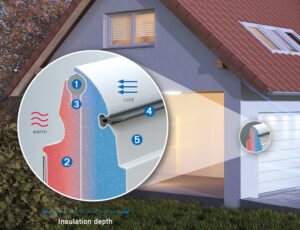
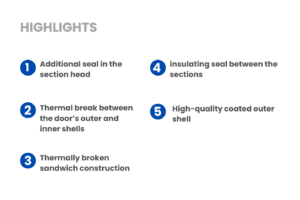
Do garage doors provide weather shielding?
With poorly insulated or low-grade products, air leaks can still occur around the edges of a garage door. This is why high-end manufacturers focus R&D on improving weather stripping around the door. Clever product innovation built into the ‘Evolution Premium’ and other models include all-surround seals (some double), as part of a ‘Thermo Frame’ design:
- In the section head
- Between each panel
- At the base of the door
Other manufacturers such as Hörmann similarly invest in weather-shielding features, with:
- Seals fitted to the floor closing the bottom edge of the door to provide barrier-free access whilst preventing the penetration of water – these seals also compensate for floor unevenness.
- Plastic profiles between the frame and brickwork to create a thermal break which improves insulation by up to 15% – a performance statistic which applies to their 5000×2250 mm double-skinned sectional garage door LPU 42 model.
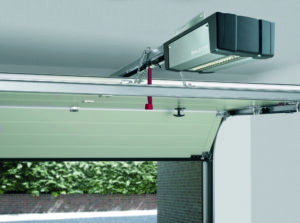
Is wood a good insulator?
It’s no surprise that timber garage doors allow for better insulation and airtightness. Cedar wood’s cellular structure creates natural air spaces that give it an insulation value higher than most woods, as well as having excellent sound suppression and absorption qualities.
Are side hinged garage doors energy efficient?
Side hinged garage doors are available in single or double skin options. Single skin doors are a cost-effective option and are best suited to spaces where there’s no need for insulation or draught sealing. Double skin doors are a thicker, insulated alternative, better suited to environments where it’s important to keep them warm and dry. The Novoferm DuoPort side hinged garage door provides a good bespoke, made to order example of this, with a 45 mm rigid Polyurethane (PUR) foam core, coupled with a block door frame providing outstanding insulation.
Polyurethane systems are among the best-performing insulation materials used in construction (See the behaviour of polyurethane systems as thermal insulators). Low thermal conductivity is reached with a minimum of thickness, making for a lighter weight product, especially when the door leaf frames are also made from high-quality aluminium.
Sectional Doors v Roller Doors – Which are the best insulators?
Sectional garage doors are better at saving energy than roller garage doors. For all the reasons given above they are intentionally made and tested for this purpose. Roller garage doors, on the other hand, are made up of individual slats, which are foam-filled. As such they are perceived to be energy efficient. However, whilst this will offer some insulation, roller garage doors are untested on a fitted door. Because the interlock between the laths/slats are not sealed they are unable to carry a meaningful U value. The gaps simply don’t prevent air and moisture from escaping.
What other advantages are there?
The heat saving designs of high-quality garage doors also have other significant benefits.
- Absorbs sound: The insulation materials absorb internal and external noise. It creates low noise when opening and closing too, reducing unsettling rattles and creaks, compared to low value doors.
- Strength: Insulated options are stronger, compared to the uninsulated options. With more resistance to dents and damage, the highest quality sectional garage doors, for example when well maintained, can have an overall lifespan of more than 35 years.
Conclusion
As energy efficiency becomes increasingly important, garage door manufacturers are making strides in improving insulation properties. New materials, multi-layered construction, improved seal design, and weather stripping, are all contributing to the creation of garage doors that are more efficient than ever before. Homeowners looking to upgrade their garage doors can now choose from a range of options that provide superior insulation and help to reduce energy bills. Government incentives around upgrading homes such as the new ECO+ scheme will also help homeowners get onboard with eco-conscious products. There has never been a better opportunity to put energy efficiency at the heart of your home improvement project.
Best Energy Saving Garage Doors
The finish that is applied to a garage door can provide hidden advantages, often unrealised by homeowners looking for high quality products.
Of course, the very best manufacturers produce garage doors to complement a home’s architectural style and personal taste, but they also ‘design-in’ important practical benefits – To help make them look good for longer and withstand ‘The elements.’
In this article, Eastern Garage Doors delves beneath the beauty of different surface finishes, with durability in mind, to explore the additional qualities they can offer.
Natural Wood
Cedar for example provides nature’s own good looks and has natural oils to help it withstand high-moisture and resist warping, cracking, or rotting. The material’s aerated organic characteristics also provides effective insulation against heat loss.
Cleaning it on a regular basis, will remove any dust or dirt that can make the wood look drab and with re-staining only required every 3 years, it takes minimal effort to keep it in pristine condition, whilst shielding it from long-term damage.
Smooth Finish
Smooth finishes are mainly used on modern and contemporary dwellings. They offer an exceptionally clean, crisp look, in keeping with this type of building design. When applied to up and over garage doors, for instance, high-grade galvanised steel is used with a zinc coating to protect the base metal against corrosion, coupled with thick powder coated paint, to deliver good resistance to chips and wear.
Meanwhile, smooth finishes on sectional door panels are also made to last with the very best manufactures delivering wear resistance and durability from multi-layers which include a sealed top coating, adhesion primer, a corrosion resistance steel layer, and additional protective coatings wrapped around a foam core with integrated thermal insulation.
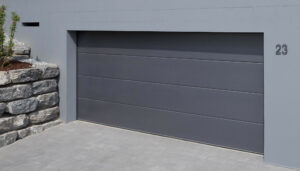
Woodgrain
From a visual perspective, this finish generally tends to be installed in period properties, converted barns, and cottages, as its life-like wood effect complements the architectural style. Its advantages are that it is very forgiving and doesn’t readily show up dents, and scratches, though if it does, minor scratches can be easily repaired. Woodgrain surface finishes emulate real wood textures, but unlike natural wood it does not need to be treated or stained.
Further attention to detail by top manufacturers’ can be seen in some designs which provide close grain textures that look like carefully sanded wood, or wide grain with a more rustic character.
Manufacturers also imitate the natural world with SLATEGRAIN surface finishes which provide a stone effect for high-end, modern architectural styles, along with SILKGRAIN finishes which given they’re ultra-silky surface can contribute to a smooth-running automated door, thereby minimising wear, and tear.
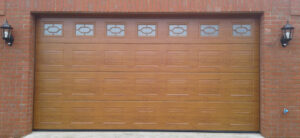
GRP
On Glass Reinforced Polyester (GRP) doors the material is reinforced with very fine strands of glass and placed into a mould to create either a smooth gloss white surface or woodgrain surface texture. The material is lightweight, durable, and easy to maintain, and can feature a UV protective gel coating, useful for coastal areas to combat sea salt, and prevent discolouration overtime.
Foil Laminated
This finish is generally installed to complement foil laminated windows and front entrance doors, it makes timber-look finishes more realistic. Its advantages are that it is a very hard-wearing surface as it is applied by a heat bonding process, with some carrying a 7-year guarantee.
Roller Door Profiles
Alongside belt systems placed between curtain layers on the very highest quality automated roller garage doors to reduce scratching, a high-quality coating on the inside and outside of the door’s surface provides additional protection and makes them easy to clean. Smooth and grain-style finishes are both available and can be fitted with an abrasion-resistant surface protection to preserve the UV-resistant plastic film coating on the profiles over a long time.
All these options can create a very different overall effect on a garage door. A useful tip would be to check all finishes that are available before making a final decision. Textures are as varied as they are pleasing on the eye, especially when looking at the best quality garage doors. So, considering them as part of the overall design is just as important as choosing the right colour, to achieve the aesthetic you want.
Moreover, understanding each option’s ability to contribute towards long-term value can protect your investment. To get the best finish, which endures the test of time, may mean spending a little bit more. However, the pay-off will save you hundreds of pounds in the long-run when compared to high maintenance, low quality, low budget options.
Garage Door Finishes – What Lies Beneath?
A garage may well have been intended for our cars, but it’s so easy for it to become a dump for our old clothes, paint cans, gardening equipment and broken junk – basically anything that we’d rather stow away and forget about. And in fact, it’s thought that only 24% of Britons are actually using a garage to store their vehicle.
But as spring rolls around, and the weather starts to brighten up, it’s the perfect time to get stuck into the mess you’ve been pretending doesn’t exist for so long.
In this blog, we’ve put together a few tips to help you reclaim your garage and make the most of this often-underutilised space.
Planning: Prepare
Throughout winter, or perhaps even longer, a lot can happen in the garage, so the first step should be to get things back to how they should be. Think about how you’ll be using the space. Are you a keen gardener? Do you enjoy artistic or crafty endeavours? Or do you use the room as a utility area?
Make a list of things that you need to do to accomplish your goals and get to work.
Planning: Execute
Tackling such a large area can seem pretty intimidating, so it’s best to stick to your guns.
We’re all different, so it stands to sense and reason that we’ll all choose a different way. For example, perhaps you’d prefer to start with easy things first, like bagging up old clothing for the charity shop, or maybe you’d prefer to empty the garage entirely and decide which bits are worth putting back.
Alternatively, if that seems too regimented for you, then start from the front and work your way to the back.
Decide What to Keep
A common rule when clearing out is if you haven’t used it for six months, it’s time to wave it goodbye. If no one has used those tennis rackets since the London Olympics, it’s probably time to get rid of them. If you’ve just never renovated that broken down old Vespa like you thought you might, then don’t worry about it – give it away to someone who might have the time.
Be honest about what you love doing, if you enjoy painting or DIY, then the kit for those activities deserves to be front and centre. But, if you’re struggling to decide what to let go, then itemise the stuff in the garage into ‘use regularly’, ‘use annually’, ‘never used’ and ‘sentimental.’
Never used can be thrown or given away, annual and regular use can be checked for signs of wear or replaced, and when it comes to sentimental items, decide what you really want and if you actually have the room to store it.
Storage Options
If space is at a premium, then consider using a pegboard with hooks for vertical wall hanging. Things like shovels, spades and the like have handles for easy storage, which also removes the need to store stuff on the floor.
Sports equipment, like golf bags and things of that nature are also easy to hang.
If you are using the garage to store gardening equipment, why not consider a potting shelf or bench, or even a wheelbarrow to make the transportation of tools much easier?
Think About Usability
Garage storage should be as thoughtful as it is inside the home, so think of the areas that are used often and plan your room around that.
If you use the area for your washing, then store all of your washing powder and dryer sheets in storage near the washer and dryer.
It’s small details like this that can help to make the process a bit easier, particularly when you’ve got a clear vision of how you want things to look and feel.
Labelling System
A great way to get the whole family behind your organisational splurge is through labelling everything. Label everything from hooks and pegboards and storage bins – this helps to maintain the order and keep everything where it should be.
It may seem like a lot, but it sure makes things easier to find, especially when in a rush and looking for the golf bag.
It will go a long way towards preventing garage clutter and keeping your doorways and floor clear of junk all year round.
Spring cleaning is not a mere one and done activity. It’s a little bit like going on a diet: you must maintain your healthy lifestyle in order to see results.
If you have any questions about garage storage, garage door conversions and alterations, or any of our other products or services, then contact us today.
For a free, no obligation survey give us a call in your local area, and our team will be happy to advise you on which products would be right for your home and garage.
How to Clean Out Your Garage This Spring
A garage door is one of the biggest and costliest pieces of mechanical kit in your home and most of us open and close the door several times a day without thinking twice. Winter can be a tough season for your garage door, and depending on the harshness of the winter – which is especially relevant depending on which area of the country you live in – there are some potential problems that could come to fruition if you aren’t careful.
Of course, having a broken garage door would be a pain during any season, but if you’re unable to get your car out of the garage during those cold, dark months, it would be far worse than any other season.
The positive news is that you can potentially avoid these by performing a little maintenance.
Garage Door Springs
Cold weather can distress a garage door in a multitude of ways, but broken springs are the most common. Wear and tear is usually the main culprit – garage door springs typically last around 10,000 cycles and with everything else we need to remember in our lives, particularly during winter, maintaining the springs on our garage doors often slips by the wayside.
Despite this, it’s important to check the springs quite often by lifting the door to halfway and letting go. If the door is stationary, the springs are in good working order. If it begins to drop slightly, then consider replacing the springs.
Another way to safeguard against broken springs in the winter is to ensure you have a safety cable installed. The cable exerts enough force to act as a counter-weight, so if your springs do break, you won’t need to worry so much.
Door Frozen to The Ground
If water pools at the base of your door, a frost overnight can freeze the water and seal the door shut.
There are no easy or fast ways to deal with this problem, but here are a few solutions which you use to try to rectify the problem:
- Manually open the door using the emergency cord. The severity of the freeze will directly impact this option.
- Pour boiling water along the base of the door. Be sure to sweep away the pool though, as it could refreeze.
- Use a scraper to chip at the ice until you can free the door.
Any of these methods takes a fair bit of time and energy, the best thing to do is to ensure you sweep away any puddle or snow build up and pour some salt around the area to prevent the reappearance of ice.
Water Damage
Especially the case with wooden garage doors, the moisture over winter can lead to the swelling of the door and the frame itself. In the worst scenario, this can close up the space, which causes rubbing.
The door can even get stuck, which prevents you from entering or exiting through the door.
It’s important to clear your rain gutters of leaves and debris to prevent water from running down onto the door, which only exacerbates the problem.
Opening Issues
Colder temperatures can meddle with the opening and closing functions of your garage door, here are a few things to watch out for:
- Lubrication Consistency – Garage door opening mechanisms require lubrication at various times throughout the year to ensure the parts run correctly. During winter, it’s not unheard of for this lubrication to alter its consistency and prevent the components from moving successfully.
- Sensitivity Problem – All automated garage doors are designed to stop the process if there is an obstruction. Thickened lubrication can alter the sensitivity of the sensors and prevent the garage from opening or closing correctly because it confuses the thickened deposits of lubrication for something it might crash into.
When the cold weather descends, your garage door may be pushed to its limits. However, by keeping an eye on your door and performing a few small tasks, preparing your garage inside and out for winter means it will be able to withstand the harsh conditions of winter.
If you have any questions about winter protection for your garage or any of our other products or services, then contact us today.
For a free, no obligation survey give us a call on 0800 048 0741, and our team will be happy to advise you on which security considerations would be right for your home and garage.


